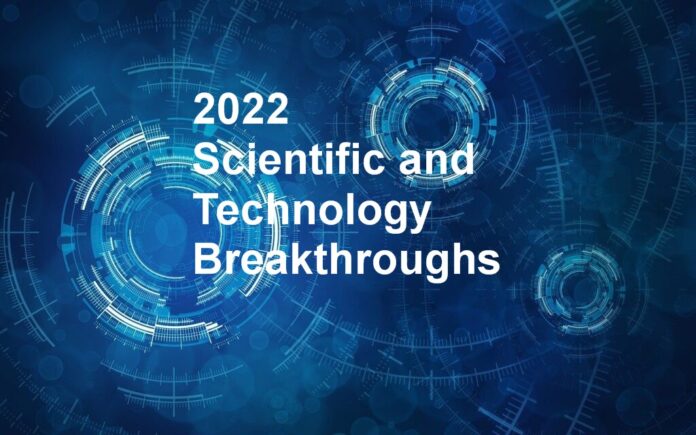Peter Diamandis of X-Prize and Singularity University fame recently sent an email blast describing this year’s breakthroughs and comparing them to those in the year 1922. Enjoy the read. In Part 1 we look at Space and Energy breakthroughs.
What were the top 22 breakthroughs of 2022? And how do they compare to the top breakthroughs of 1922, 100 years ago? Back in 1922 in the United States and the rest of the world, we were just emerging from the aftermath of the Spanish flu. In that year, the United States had:
- Approximately 12 million cars were on the road.
- The price of gas was 11 cents per gallon.
- The Ford Model-T cost a mere $319.
- Only 40% of Americans had electricity in their homes.
- Only 35% had a telephone.
- Life expectancy was 58 years for men and 61 years for women (about 20 years less than today).
The top breakthrough inventions of 1922 included:
- The first water skis were demonstrated using wooden boards and a clothesline.
- The first manually retractable, convertible car hardtop was invented.
- The electric blender was invented for making malts and milkshakes.
- The radial arm saw was invented to cut and shape long pieces of stock material.
- The use of insulin for the first time in a person to treat diabetes.
- Vitamin E was discovered.
- And Down Under, the Australians invented Vegemite.
Now compare that to the top 22 breakthroughs of 2022 covering space, energy, health, food, robotics, quantum computing, and artificial intelligence.
Space
The #1 breakthrough in my book is The James Webb Space Telescope (JWST). Its successful launch and deployment represent the most sophisticated and complex observatory ever constructed. At a cost exceeding $10 billion, JWST is an infrared observatory orbiting the Sun about 1 million miles from Earth. Its primary mirror is 21.3 feet (6.5 meters) across and can image objects 9x fainter than its predecessor, the Hubble Telescope.
JWST was designed to study the most distant objects in the universe, including the first stars and galaxies that formed after the Big Bang. Its mission will unveil unprecedented details about the Universe’s origins and lead us to new cosmological discoveries, and even help to search for signs of life on other worlds. Scientists can now see the Universe as it appeared mere 100 million years after the Big Bang
The #2 breakthrough was DART, the Double Asteroid Redirection Test which deliberately smashed a spacecraft into a 160-metre-wide moonlet accompanying a larger asteroid. The impact velocity was 22,500 kilometres (14,000 miles) per hour causing the moonlet to alter its orbit significantly. The mission was deemed a great success for future planetary defence with the Earth in constant danger of being impacted by an asteroid. A 1903 event, the Tunguska Incident, levelled 1,000 square kilometres (400 square miles) of Siberian forest back then with a 12 Megaton blast. With Tunguska-sized events happening about once every thousand years, and 5-kiloton air bursts about once per year, the threat to Earth from an impactor is very real. And astronomers only have detected about 40% of the estimated 25,000 near-Earth asteroids that pose a threat. The DART mission, however, demonstrated a viable defence.
Energy
The #3 breakthrough occurred this month with net positive fusion output achieved. Scientists at California’s National Ignition Facility at the Lawrence Livermore National Laboratory announced a net energy gain in a fusion reactor for the first time. Fusion research has been pursued for decades. While this particular form of fusion will require a lot more work to reach commercial utility, it inspires us to show what is possible in the future. It is worth noting that there are currently 37 privately funded fusion companies working on commercializing various forms of fusion. One example is Commonwealth Fusion Systems, spun out of MIT in 2017, which is building a tokamak the size of a tennis court, backed with $250 million in private capital.
Fusion reactors require very small amounts of hydrogen. The hydrogen in a glass of water could provide enough energy for a lifetime. Fusion creates no radioactive waste. With the U.S. pledged to eliminate all carbon dioxide emissions from the electricity sector by 2035, adding fusion to solar, wind, hydropower, and mini-fission nuclear reactors would help achieve this audacious goal. And nuclear fusion would be a far superior solution to provide abundant clean energy.
The #4 breakthrough is small modular reactors (SMR) achieving U.S. Nuclear Regulatory Commission approval. The first of these to be built in the United States is the NuScale Power Module. At less than 25 metres (80 feet) tall, this SMR will generate enough clean electricity to power a city of 60,000 homes. It is expected to be completed in Utah and running by the end of the decade and should operate continuously for 60 years without any major overhaul.
In shrinking reactors, the nuclear industry is making them safer, cheaper, and faster to implement. The NuScale reactors will be manufactured off-site and will have lower operating costs than traditional reactors. Globally, nuclear power supplies just 11% of electrical power, down from approximately 18% in 1996. NuScale’s SMR will take up 1% of the space of a conventional reactor, which will allow for SMRs to be stacked side-by-side and efficiently minimize space while maximizing power production. It is hoped that these SMRs, being smaller, cheaper, and safer will allow nuclear power to increase its footprint in global energy production.
Stay tuned for Part Two when we look at the health breakthroughs of 2022.
















